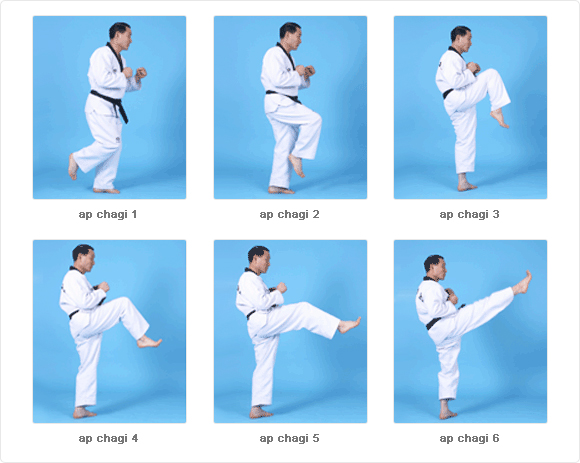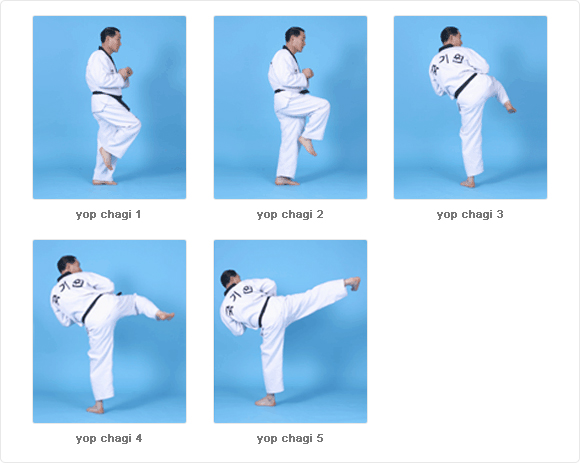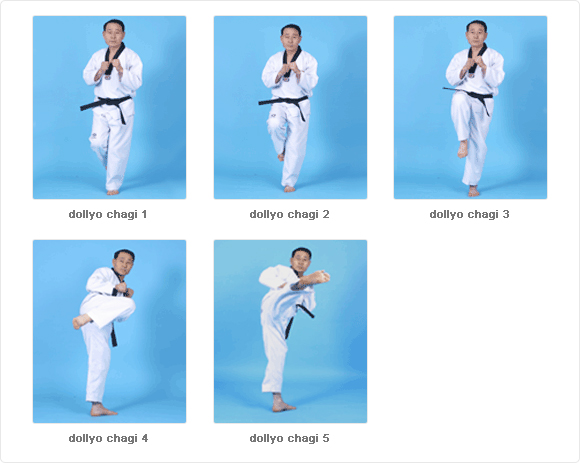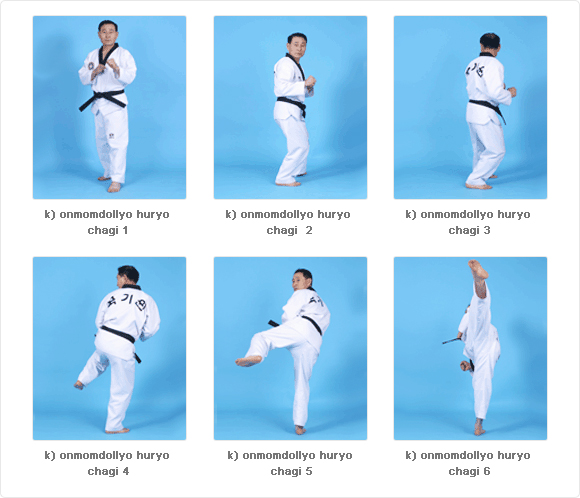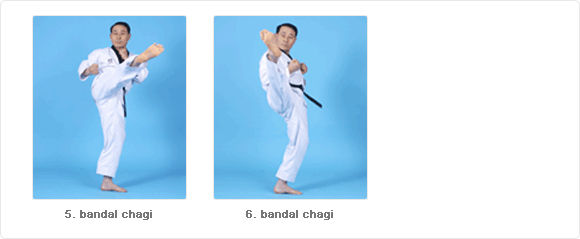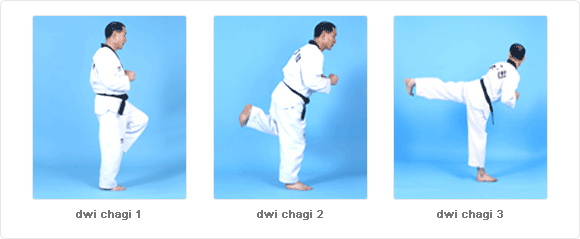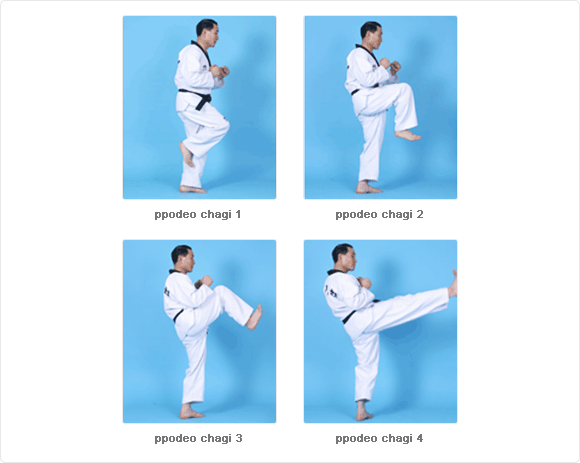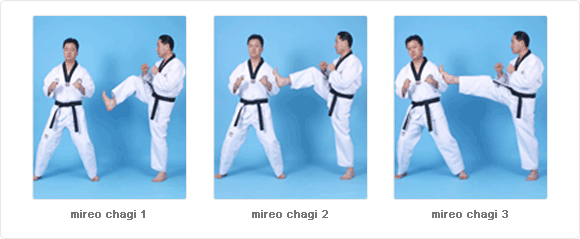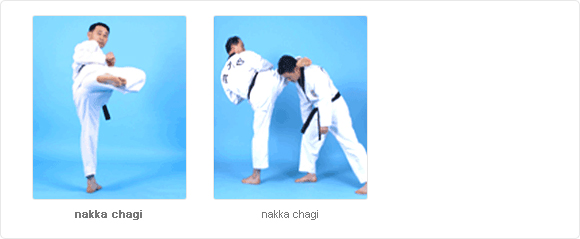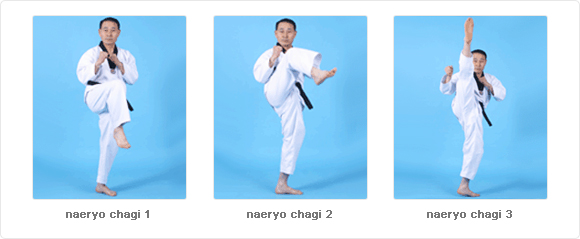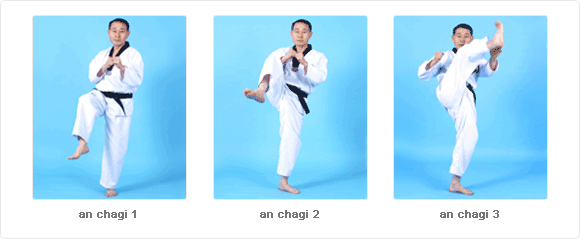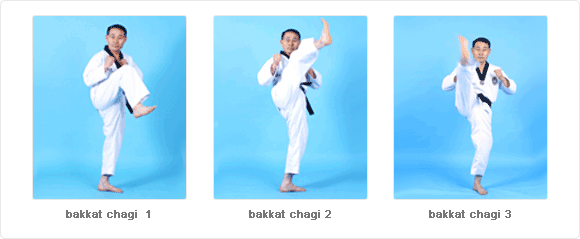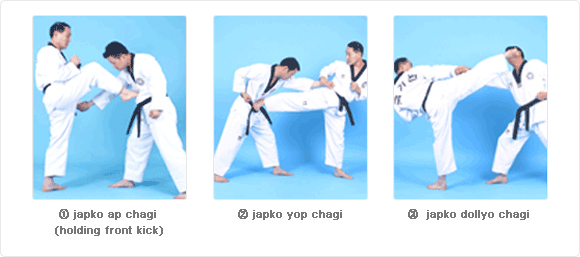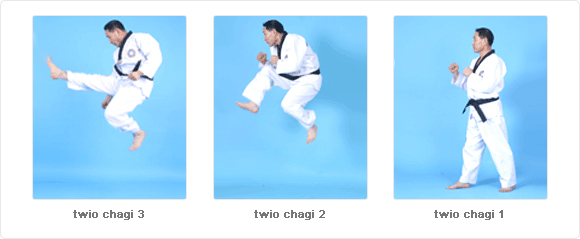A chagi is a technique to overpower the opponent by making use of the foot manipulated by the motion of leg. The chagi can be performed by using the force at the time of extending the bent and folded knee or the flexion force of the extended leg, making use of the body’s turning force. The chagi techniques are classified by the motion of leg and foot, and the kicking power diggers according to the applicable parts of the body. There are also other classification methods according to the way of kicking either by holding the opponent or using the impellent force.
1. Ap Chagi (front kick)
- First, raise the folded knee of the kicking leg up to the breast and immediately push the foot forward, fully stretching the leg. The track of foot must be on a straight line toward the target.
- The target must be kicked by the fore sole, the toes bending outward. The groin, lower part of abdomen, solar plexus, chin, etc, are the targets.
- The kicking foot is drawn back by reaction to its original position. However, the foot may be placed where the attacker can easily make a next movement. If the attacker keeps himself or herself out of balance while he or she executes a kicking or he or she retreats the kicking foot, the chagi was not perfect.
- The supporting leg on the ground should not stretch the knee fully before or during the kicking because the upright standing is more likely to cause falling down of the attacker or weakening of the kicking force. Nor is easy to make next movement.
- If the standing leg is supported by the entire sole of foot, the weight is laid on the hip joint and the knee joint, in which case the kicking is less speedy and powerful of impulsive force. Sometimes, the knee joint or the hip joint breaks away. Therefore, it is necessary to lift the heel slightly by stretching the ankle so that the fore sole may pivot at the moment of a kick and then the back sole will touch the ground again after the kick. However, one should be careful not to stretch the ankle too much, because it would lift up the center of weight.
- The fore sole is generally used in the apchagi but occasionally the toes are also used when such vital parts as groin and solar plexus are to be targeted. The foot back also can be used in the apchagi uniquely for an attack of groin, which is called “ap ollyeo chagi” (front lift up kick).
2. Yop chagi (side kick)
- As in the apchagi, one lifts up the kicking leg, folding the knee, and then stretches the folded knee as he or she turns the body in the opposite direction to the target and kick the target with the back sole of foot.
- At the moment of the kick, the base of the kicking leg twists at the pelvis in a manner of turning over and the head is raised to keep the eye fixed at the target. At this moment, the trunk also twist like a spiral from the shoulder to the pelvis region and the leg. Therefore, the back sole can kick the target powerfully by spiraling just as a bullet passes through the rifle barrel spiraling. The target is determined according to the opponent’s position; if the opponent is facing the front, the target will be the face or the solar plexus and it will be the flank or the side chin, if the opponent stands sideways.
- After the kick, the kicking leg will be drawn back to the original position or where it is intended to be placed for next moves.
- The other leg supporting the body will assist the kick by pivoting on its fore sole, stretching the ankle and help accelerate the speed of kick by stretching knee simultaneously. At the time of retreating the kicking leg, the supporting leg’s ankle and knee will be lowered again.
- At the moment of a yopchagi, the upper body should not be left falling in the direction opposite to the target. The upper part of the body must be raised so that the entire body may from a “y” letter shape, enabling the weight to be converted into impellent force of kick.
- A yopchagi applies the back sole and the foot blade in attacking and they must move on a straight line from the starting point to the target.
3. Dollyo chagi (round house kick)
- Putting the weight on the pivoting foot, one turns the body immediately after folding the knee and, as the knee stretches, makes the kicking foot circle horizontally so that the fore sole may kick the target(The foot back can also be used as the kicking part).
- The supporting leg stretches its ankle and knee to help the fore sole pivot the body easily.
- The kicking leg must stop at the time of kicking the target without making a follow through.
- Unlike the apchagi or yopchagi, the kicking foot does not make a straight line track. The foot is first raised and then begins to move in a circle.
- After a hard training, the dollyochagi will be able to make a pounding kick from above the target at the time of kick.
- The basic techniques of chagi consist of apchagi, yopchagi and dollyochagi, but there are variations in the chagi techniques.
4. Momdollyo chagi (turning back kick)
From wen apseogi, the explanation of momdollyo chagi is as follows:
- Looking toward left foot, one’s body turns 180 degrees one’s eye turns 360 degrees to clockwise rotation.
- When the body is turned, at the same time foot moves together and put forth, right forward stance, it is called ban momdollyo chagi.
- One’s body and leg used for kicking turn 360 degrees completely, the kicked foot is put at the begining position again, it is called “momdollyo chagi”.
- To kick at the right forward stance, when the body is started to turn, left foot put one step forth, and left foot can be pivot, turns to clockwise rotation, kicks with right foot, it is called “onmomdollyo chagi”
The sort of momdollyo chagi
a) ban momdollyo chagi
b) ban momdollyo yop chagi
c) ban momdollyo huryo chagi
d) ban momdollyo nakka chagi
e) ban momdollyo naeryo chagi
f) momdollyo yop chagi
g) momdollyo huryo chagi
h) momdollyo nakka chagi
i) momdollyo naeryo chagi
j) onmomdollyo yop chagi
k) onmomdollyo huryo chagi
l) onmomdollyo nakka chagi
m) onmomdollyo naeryo chagi
- “The momdollyo-chagi is often misunderstood so that it is called “dwit-chagi”(back kick), “360 degrees dollyo-chagi”, “dwidolla-chagi”. And also the dollyochagi is sometimes called
5. Bandal chagi (dichotomy kick)
This is the medium style of the apchagi and dollyochagi. The fore sole or the foot back delivers a kick by making a slant circle of movement.
6. Bitureo chagi (twist kick)
- If the right foot is kick from the wen apkubi (left side forward inflection) stance, the right foot passes the front of body, as the knee is folded and raised as in the apchagi, toward the left side of the body and then abruptly turns toward the right side, finally stretching the knee to deliver a kick. The applied parts are the fore sole and the foot back.
- The body also turns to the left side and then reverses to the right side.
- The left foot as a pivot is the same as in the apchagi. The ankle will be slightly streched and the knee slightly bent at the time of kicking.
7. Dwi chagi (back kick)
- From the standing position, one lifts up the kicking leg and stretches it backward to deliver a kick. The back is sole is used for the kick.
- The ending of the kick is similar to the yopchagi.
- The foot of the fore leg is used for the kick or that of the back leg can be also applied for the kick after it is drawn closer to the fore leg. The former case is applied when the opponent is distance while the latter when the opponent is closer to the attacker.
- The eyes are directed toward the kicking side and the supporting leg may not stretch the knee the ankle as in the yop chagi.
- The upper part of the body leans more forward than in the yopchagi.
8. Ppodeo chagi (stretch kick)
- This is similar to the ap chagi; the knee of kicking leg does not fold too much. The foot is simply lifted up in the right front to deliver a kick by stretching.
- Unlike the apchagi, the foot does not face upward, but simply moves forward by the stretch of leg to counter the opponent’s advance. The kick mainly target below the trunk.
- The entire sole is used for the attack of the trunk, but an attack with the back sole, by crooking the ankle, may inflict a more powerful impact on the target. And it is also possible to use the foot blade for a kick when the ankle is drawn closer to the supporting leg.
- When the groin is to be attacked, the toes will be straightened for a stretch kick.
- The upper part of the body leans a little more backward than in the apchagi.
9. Mireo chagi (pushing kick)
- The way of kicking is the same as the yopchagi or the ppodeochagi (stretch…), but the kicking is slowed down, merely pushing the target instead of inflicting a blow.
- This is used especially when the target is nearer. Instead of inflicting a vital damage, this technique is intended to throw down or push away the opponent.
- The sole of foot is used for the kick
10. Nakka chagi (hooking kick)
- a) When the opponent has evaded the kick at the moment of delivering a kick attack and comes closer to the attacker, the kicking leg, which has missed and passed the target will attack the back of the opponent’s head or the back by the force of folding the stretched knee.
- b) If a dollyochagi has missed the target, the kicking leg will instantly fold the knee, delivering a kick by the heel.
11. Huryo chagi (thrashing kick)
- The kicking leg will be lifted high up above the opponent’s head and inflict a kick, bringing down the leg with the knee keeping stretched.
- If the opponent is not so close, just lift up the folding knee to the center of the body and then make a “naeryo chagi” by bringing down the foot.
- When the opponent is near and the attacker’s leg is lifted up from the inner side of the attacker, the “bakkat naeryo chagi” (outer…) is possible to be made. If the kicking leg is lifted up from the outer side of the attacker, the “an naeryo chagi” (inner…) is possible.
- The heel and the sole are used for this kick.
12. Naeryo chagi (downward kick)
- The kicking leg will be lifted high up above the opponent’s head and inflict a kick, bringing down the leg with the knee keeping stretched.
- If the opponent is not so close, just lift up the folding knee to the center of the body and then make a “naeryo chagi” by bringing down the foot.
- When the opponent is near and the attacker’s leg is lifted up from the inner side of the attacker, the “bakkat naeryo chagi” (outer…) is possible to be made. If the kicking leg is lifted up from the outer side of the attacker, the “an naeryo chagi” (inner…) is possible.
- The heel and the sole are used for this kick.
13. An chagi (inner kick)
Just like the bandalchagi, this kick is executed by making the kicking foot draw a circle from outside to inside. The back of foot blade is used for this technique, which is applied at the moment of lifting up the foot before a naeryochagi or in the course of a pyojeok (target) chagi.
14. Bakkat chagi (outer kick)
The opposite way of anchagi. It is similar to a bitureo chagi, using the back ot the foot. It is mainly used in makki technique.
So far we have discussed some simple techniques of chagi, which use one foot on the ground in maintaining the balance and the other moving in the air in delivering a kick against the opponent’s bodily parts. It is generally said that the foot techniques (chagi) can exert the power three times that of hand techniques (jireugi). However, if the foot techniques are not swift and accurate enough, their impact power becomes meaningless and are likely to cause unbalance of the body and the opponent’s counterattack or evasion. Also certain unsuccessful kick will result in consuming the attacker’s energy almost three times that of the opponent. Therefore, it is imperative to train hard in mastering the foot techniques.
There are various composite techniques to supplement those simple chagi techniques, which will be explained in the following.
Composite Techniques of Chagi
- Japko chagi (holding kick)It is sometimes necessary to hold the opponent by the dobok or the bodily parts before delivering a kick in an attempt to bear down the opponent, thus doubling the effect of the blow.
- Japko ap chagi (holding front kick)
- Japko yop chagi (holding side kick)
- Japko dollyo chagi (holding round house kick)
- Japko bandal chagi (holding dichotomy kick)
- Japko bitureo chagi (holding twist kick)
- Japko nakka chagi (Japko hooking chagi)
- Kullo chagi (stamping kick)Mainly from the dwitkubi (backward inflection) stance (or juchumseogi, beomseogi, apseogi), one raises the fore foot, and makes it stamp on the ground, moving the body forward by the impellent force, and as soon as the back foot follows the fore foot, landing on the ground, he or she makes the fore foot deliver a kick. This technique is intended to deceive the opponent pretending to attack at the first movement but actually the attack comes a moment later.
- Kullo ap chagi
- Kullo yop chagi
- Kullo dollyo chagi
- Kullo bandal chagi
- Kullo bitureo chagi
- Kullo ppodeo chagi
- Kullo mireo chagi
- Kullo nakka chagi
- Kullo naeryo chagi, etc.
15. Twio Chagi (jumping kick) Ildan Chuk (single stage jumping kick)
This is a technique of kicking by one foot while the body jumps up in the air. It is possible to perform this technique from the moaseogi, but in general it can be better carried out from the dwitkubi stance, in which the two feet are wide apart, fore and back, (or juchumseogi and nachuwoseogi whose feet are apart, left and right, or beomseogi and apjuchumseogi) beacause the two feet push the ground simultaneously to jump up in the air. Either the fore foot or back foot alone can push the ground to lift up the body in the air.
When the fore foot is used to deliver a kick, it is called the “twio chagi” (jump kick). If the back foot carries out the kick by turning the body toward the front at the moment of jumping in the air, it is called the “twio bakkuwo chagi” (jump altering kick). If the body turns backward by jumping in the air performs a kick by the back foot, it is called the “twio banmomdollyochagi” (jump half turning kick).
- Types of jump kicks: In a broad sense, the jump kicks are classified into 3 categories but there are many detailed types of jump kick
Types of twio chagi
a) Twio ap chagi
b) Twio yop chagi
c) Twio dollyo chagi
d) Twio bandal chagi
e) Twio mireo chagi
f) Twio bakkuwo ap chagi
g) Twio bakkuwo yop chagi
h) Twio bakkuwo dollyo chagi
i) Twio bakkuwo bandal chagi
j) Twio bakkuwo mireo chagi
k) Twio momdollyo yop chagi
l) Twio momdollyo nakka chagi
m) Twio momdollyo huryo chagi
n) Twio momdollyo naeryo chagi, etc.
16. Dubal dangseong chagi (two feet alternate kick)
After the body jumps up in the air, two feet perform kicks alternately. The back foot kicks first and the fore foot later.The first kick is in the disguise or aims at a lower part, and the later kick must kick the target accurately and higher.
- The dubal dangseong chagi can be performed either by advancing forward to reach the distanced opponent or by jumping up higher to reach a high target.
Types of dubal dangseong
a) Dubal dangseong ap chagi
b) Dubal dangseong yop chagi
c) Dubal dangseong dollyo chagi
d) Dubal dangseong bandal chagi
e) Dubal dangseong mireo yop chagi, etc.
17. Modum chagi (joint feet kick)
Jumping up in the air, one joins the two feet close and make them kick the same target at a time. When jumping up, the two feet are drawn closer to push up the body.
Types of modumbal kick
a) Modumbal ap chagi
b) Modumbal yop chagi
c) Modumbal dollyo chagi
d) Modumbal bandal chagi
e) Modumbal mireo yop chagi
f) Modumbal mireo ap chagi, etc.
18. Kawi chagi (scissors kick)
As in the modumbal chagi, the two feet kick two targets at a time by separating the feet from each other.
Types of kawi chagi
a) Kawi ap chagi
b) Kawi yop chagi
c) Kawi dollyo chagi
d) Kawi mireo ap chagi
e) Kawi mireo yop chagi, etc.
19. Kodeup chagi (repeated kick)
One leg performs more than two kicks in the same manner. Generally, the first kick aims at underneath targets while the second at the trunk or the face. However, repeated kicks can be directed to the same target. The first kick is largely intended to deceive the opponent and the second one must be perfect to overpower him or her. The kodeup chagi is also broken down into three types: (a) kodeup chagi, (b) kodeup yop chagi, and (c) kodeup dollyo chagi.
Types of kodeup chagi
a) Kodeup ap chagi
b) Kodeup yop chagi
c) Kodeup dollyo chagi
20. Sokkeo chagi(mixed kick)
One foot perfoms more than two chagi tecniques. At the time of delivering the second chagi, the foot once fails down, but without touching the ground, changes the direction and applies a chagi technique. An unskilled kicker is likely to make the second kick after touching the ground by the kicking foot. In order to get closer to the opponent, the supporting foot slips deep toward him or her at the same time that the second kick is delivered. Sometimes, the kicking foot touches the ground lightly in order to accelerate the impellent force before carrying out the second kick, rushing into the opponent.
Types of sokkeo chagi
a) Ap chago dollyo chagi
b) Ap chago yop chagi
c) Bitureo chagi hago(and) dollyo chagi
21. Yio chagi (successive kick)
The same chagi techniques is applied alternately by left and right foot.
22. Yio sokkeo chagi (successive mixed kick)
The different chagi techniques are applied when the left and right foot deliver kicks alternately.
23. Twio yio chagi (jumping successive kick)
While keeping the body in the air after jumping, one executes the same chagi technique alternately by each foot.
24. Twio nomeo chagi (jumping over kick)
Jumping over the obstacle, one deliver a chagi technique. There are a high jump over short kicking and a long jump over distanced kicking.
25. Ilja chagi (single line kick)
Pushing up the body in the air, one opens up the feet left and right on a single line toward each target and delivers simultaneous kicks. Usually a yopchagi and a bitureochagi are applied concurrently. Some calls this the kawichagi (scissor kick) but it is not correct. There are two types of iljachagi
Supyong ilja chagi (horizontal ilja chagi):
This is applied when the two targets are horizontally placed.
Bikkyo ilja chagi (different height ilja chagi):
The two targets are placed with different heights from each other.
26. Dabanghyang chagi (multi direction kicks)
While the body is kept in the air, more than targets are kicked. Foot techniques are numerous, so this is called the multi direction chagi. Applicable actions are both foot techniques and hand techniques.
Teuksu Chagi
1. Wesanteul yop chagi(single hand wide open makki and yop chagi)
While the arms make wesanteul makki, a yopchagi is delivered at the same time. Defending a jireugi attack from the rear by an outer makki, one delivers a yopchagi simultaneously, which is accompanied also by a jireugi of the other hand.
2. Pyojeok chagi (target kick)
By setting an imaginary target in the palm, one practices “an chagi” (inner kick) by the foot blade or other.

